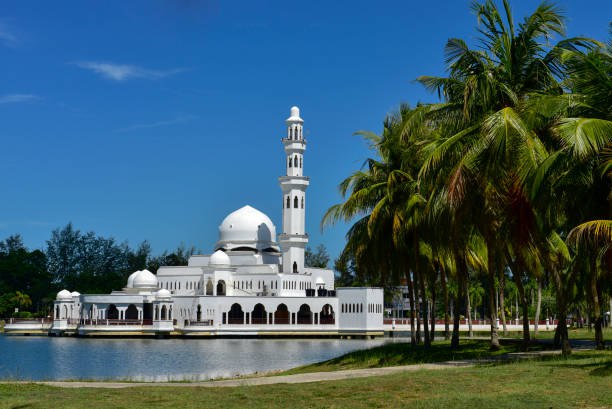Culture, Arts & Heritage of Batu Burok Kuala Terengganu
Terengganu has a distinct cultural personality and is blessed with some of Malaysia’s most wondrous attractions, making it a leading tourism destination in the country. Visitors are enthralled by it’s wealth of traditional arts, culture and rich Malay heritage. Terengganu is where people come to experience the authentic way of life in the East Coast of Malaysia, expressed through life in the laidback towns and fishing villages and to feast their senses on artistic pursuits of traditional cultural performances which have been lovingly preserved. It is also rich with a myriad of customs and traditions, upheld through generations and visible in its way of life, its arts and handicrafts, its traditional culinary style together with heritage. Terengganu is in a league of its own as a vibrant tourist destination. Be enthralled by the flock of dancers that evoke spirits, be entertained by traditional games that spin fun and excitement because it is truly a tropical gateway where you will definitely revitalize your senses in discovering the splendours of nature, the diversity of tradition and the fascinating Heritage.
DIVERSE TRADITIONAL CUISINE OF TERENGGANU
1-NASI DAGANG
When come to Terengganu people must try Nasi Dagang.Also, at Kg. Batu Burok, Kuala Terengganu there is a famous Restaurant that sell nasi Dagang
.Nasi Dagang is a rice specialty
of Terengganu. The dish is
made by steaming a mixture
of regular and glutinous rice
in coconut cream over low
heat. It is eaten with its own
specially made side dishes of
tuna curry and lightly pickled
vegetables. Simplicity is its
essence. ‘Dagang’ literally
means going out on a trading
trip. It is practical to pack
along Nasi Dagang to be
eaten along the way.
2-KEROPOK
Some call them fish fritters, fish sausages or fish sticks but in Terengganu, it is a popular evening snack everyone knows as ‘keropok’. ‘Keropok lekor’ is actually made from processed fish meat mixed with salt and sago flour. This mixture is then hand rolled into sausages shaped around 6 to 10 inches long and immediately cooked. There are three types of keropok, mainly keropok lekor (boiled chewy ones), keropok goreng (fried chewy ones) and keropok keping (sliced, sun-dried and fried). There is also a steamed Teochew-style lekor, exclusive to Chinatown, made with ikan parang (wolf herring) and it is whitish in colour as compared to the normal dark brownish lekor. Even the sauce is different with its ingredients made out of chili and shrimp paste as compared to the normal homemade chili sauce. The tastier Terengganu ‘keropok’ retains its identity by having more fish meat as its main ingredient.
3-KUAH SINGGANG
This is definitely a Terengganu dish: fish cooked in clear broth of tumeric, galangal, shallot and other spices. Normally best eaten with steamed rice and a combination of traditional Malay concoction of fresh palatable leaves and herbs with healing properties served with fresh vegetables and the famous fermented anchovy sauce. Adding hot chilli peppers will surely add to the fiery taste of the dish.
4-LAKSA TERENGGANU
This dish consists of white rice noodles either eaten with delicious meat gravy or curry gravy. When eating ‘laksa’, the taste lies in the added assortment of fresh bean sprouts, long beans, cucumbers and other fresh palatable leaves. Chili paste, shrimp paste and salt are added to suit one’s requirements.
5-NEKBAT
A spongy unsweetened pastry soaked in sugary syrup.Nekbat is popular during during Ramadhan season and they usually sell it at ‘Bazar Ramadhan’. So there is no other place that you can find the nekbat other than ‘Bazar Ramdahan’ because it is quite hard to find during normal day. Nekbat is usually served during Ramadhan as dessert. If you really want to try, you can buy the sugary nekbat from Ramadhan markets all over Terengganu or if you want to try to make it by yourself you may buy the plain nekbat from the market.
Heritage of Kg. Batu Burok, Kuala Terengganu:
1-Masjid Tengku Tengah Zaharah (Masjid Terapung)
The mosque, which began construction in September 1991 and was completed in mid-1994, worth RM6.997 million, managed by the Public Works Department, was designed by Dato' Raja Kamarul Bahrin Shah Raja Ahmad, from Seni Bahri, featuring the characteristics of Islamic civilization and a combination of local architecture.
With an area of 1,372 square meters and a 30- meter- high minaret , a large dome and five waqfs and surrounded by 1.5-meter-deep water, it can accommodate a congregation of up to 1,000 people with a men's prayer hall at the bottom and a women's prayer hall at the top.
The mosque which was inaugurated by Al-Marhum Sultan Mahmud provides other facilities such as royal rooms, small library, imam's room and office, store, ablution place and parking area that can accommodate more than 400 vehicles.
With the combination of garden decoration, the color of the blue sky, the glint of sunlight from the surface of the water that surrounds the mosque and the wind blowing from the South China Sea , it must be the most comfortable and peaceful mosque, giving a sense of how the majesty of Islam is encapsulated in a form of civilization that continues grow.

2-THE ART OF KITE MAKING
Kite flying is one of the popular traditional pastimes in Terengganu. It was once played by farmers on leveled ground after the harvesting season. Today, kite-flying attracts people from all walks of life. Kite or Wau (pronounce as ‘wow’) can appear in all shapes and sizes. The most popular kites in the east coast are the moon kite (wau bulan) and cat kite (wau kucing). Kite making requires patience and tremendous skill as it applies the elements of physics and mathematics. There are kites that are made using the batik technique or painted by batik artists and the designs are always more creative and less formalized by tradition. Other than the joy of kite flying, the decorative traditional kite adorns the walls, making it the pride of the owner.
3-HAND DRAWN / BLOCK PRINT BATIK
The word “Batik” means “drawing out with wax”. The coloured and patterned cloth has gained popularity not only in Malaysia but also in international fashion scenes. This fabric normally carries motifs that reflect the flora and fauna, geometry and landscape of nature. Terengganu Batik is renowned for its vibrant colours, bold prints and its versatility. It is soft, light and breezy and very well suited for the summer and tropical climate and its fabric is made into shirts, dresses, crepe de chine, scarves, kaftans, sarongs, pillow cases, bags, table cloths and many more items. There are two types of batik, the hand drawn and the block print. The hand drawn is based on the artist’s imagination and creativity. The artist begins by using a small pen-like container filled with hot-melted wax. It is then hand-drawn onto a white fabric with hot liquid wax creating a design. Brushes are then used to paint dyes within the outlines, thus allowing for the creation of shaded and multihued designs. The gracefulness and speed of their freehand never ceases to amaze one’s attention. It is a beauty of the highest form of traditional batik where each hand-drawn article of clothing is unique.
4-SONGKET WEAVING
Songket is a brocade of woven silk or cotton interwoven with either silver or golden threads. Songket weaving is another old craft used to produce intricate fabric that is still popular for wedding events and official ceremonies. Like batik, there are still many songket weavers producing quality songket that is in demand by the royals, dignitaries, ministers and state officials for use on special ceremonial occasions. Songket weavers continue to expand the horizon of opportunities for songket. Exclusive Malaysian Resorts use songket to infuse the modern and traditional in forming a crystal-clear Malaysian identity. State Houses and Government buildings adorn their foyers and amphitheatres with songket panelling to reinforce Malaysia’s heritage. Today, the true Malay Songket is sublime. It has finally developed a love story enriched with art, passion, tradition and identity.
5-BOLA CETONG
This game is played by a group of boys and girls and are evenly divided into 2 groups; ie, the Can Keeper and the Thrower. After a decisive vote of sticks, tin cans are arranged in a pyramid formation on a piece of a plank of wood. The game starts when members of the Thrower side will take turns throwing a rubber ball at the cans to displace them. Each of them is given three chances to hit all the cans and until one of them strike the cans to the ground. The Keeper will take turns to throw the ball to any Thrower members who will sort and rearrange the fallen cans without being hit by the ball. The group exchanges sides if they fail to arrange all the cans and the game starts afresh.

 HOME
HOME KG BATU BUROK
KG BATU BUROK ATTRACTIVE PLACE
ATTRACTIVE PLACE SERVICE
SERVICE FACILITIES
FACILITIES EVENTS
EVENTS CONTACT
CONTACT